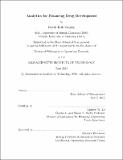Analytics for financing drug development
Author(s)
Fagnan, David Erik
DownloadFull printable version (1.368Mb)
Other Contributors
Massachusetts Institute of Technology. Operations Research Center.
Advisor
Andrew W. Lo.
Terms of use
Metadata
Show full item recordAbstract
Financing drug development has a particular set of challenges including long development times, high chance of failure, significant market valuation uncertainty, and high costs of development. The earliest stages of translational research pose the greatest risks, which have been termed the "valley of death" as a result of a lack of funding. This thesis focuses on an exploration of financial engineering techniques aimed at addressing these concerns. Despite the recent financial crisis, many suggest that securitization is an appropriate tool for financing such large social challenges. Although securitization has been demonstrated effectively at later stages of drug development for drug royalties of approved drugs, it has yet to be utilized at earlier stages. This thesis starts by extending the model of drug development proposed by Fernandez et al. (2012). These extensions significantly influence the resulting performance and optimal securitization structures. Budget-constrained venture firms targeting high financial returns are incentivized to fund only the best projects, thereby potentially stranding less-attractive projects. Instead, such projects have the potential to be combined in larger portfolios through techniques such as securitization which reduce the cost of capital. In addition to modeling extensions, we provide examples of a model calibrated to orphan drugs, which we argue are particularly suited to financial engineering techniques. Using this model, we highlight the impact of our extensions on financial performance and compare with previously published results. We then illustrate the impact of incorporating a credit enhancement or guarantee, which allows for added flexibility of the capital structure and therefore greater access to lower costing capital. As an alternative to securitization, we provide some examples of a structured equity approach, which may allow for increased access to or efficiency of capital by matching investor objectives. Finally, we provide examples of optimizing the Sortino ratio through constrained Bayesian optimization.
Description
Thesis: Ph. D., Massachusetts Institute of Technology, Sloan School of Management, Operations Research Center, 2015. This electronic version was submitted by the student author. The certified thesis is available in the Institute Archives and Special Collections. Cataloged from student-submitted PDF version of thesis. Includes bibliographical references (pages 133-139).
Date issued
2015Department
Massachusetts Institute of Technology. Operations Research Center; Sloan School of ManagementPublisher
Massachusetts Institute of Technology
Keywords
Operations Research Center.